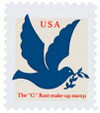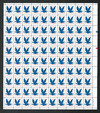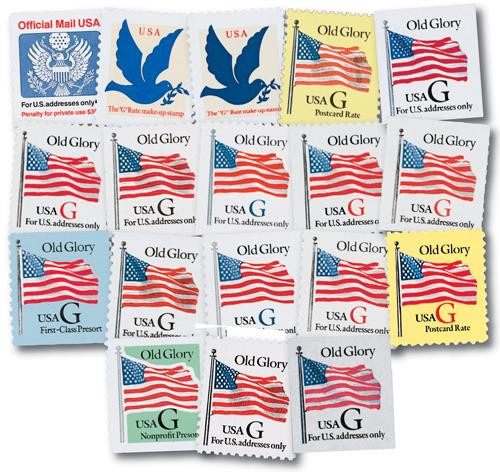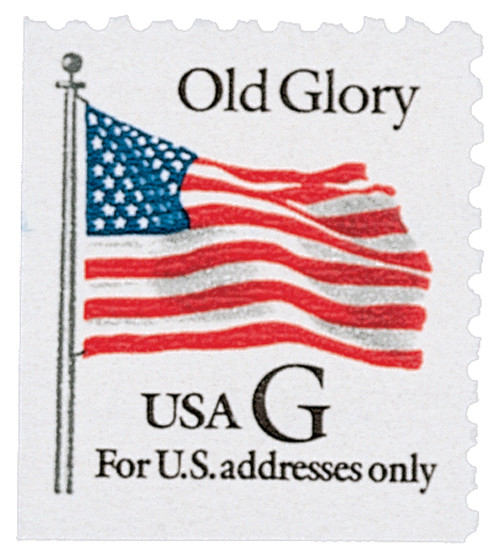
# 2878 - 1994 3c Dove, SV Make-up rate
U.S. #2878
1994 Make-up rate Dove
- Issued as a non-denominated stamp
Stamp Category: Definitive
Set: G Series
Value: 3¢ Make-up Rate
First Day of Issue: December 13, 1994
First Day City(s): Washington, DC
Quantity Issued: 600,000,000
Printed by: American Bank Note Company
Printing Method: Gravure
Format: Panes of 100, vertical, 10 across, 10 down.
Perforations: 10.9
Why the stamp was issued: This stamp was used to “make-up” the rate between the old rate (29¢) and the new G-rate of 32¢
About the stamp design: The make-up rate stamp of 1991 was criticized for being wordy. With this stamp they chose to go with a simple design instead with simple wording. Richard Sheaff, of Sheaff Design Inc., found the flying dove from archives of past concepts. The designer was Robert Brangwynne.
Special design details: Two printers printed the same stamp – American Bank Note Company (ABNC) and Stamp Venturers. The two stamps can be told apart because the ABNC dove is bright blue and has thin type, while the Stamp Venturers has a dark blue dove and bolder type.
About the printing process: The stamp was printed by Stamp Venturers at J.W. Fergusson and Sons in Richmond, VA, on a Champlain webfed gravure press. Stamps were then perforated, processed, and shipped by Stamp Venturers, Milwaukee, Wisconsin.
First Day City: Most definitive stamps that don’t receive a first day ceremony get issued in Washington, DC which is home of the United States Postal Headquarters.
About the G-rate Series: The USPS issued G-rate stamps to aid in the transition of a new postal rate. All, except two, G-rate stamps picture the US Flag with “Old Glory” in text above it, the other two are blue doves. They released eighteen different versions of G-rate stamps. These came in six different formats, in five varied rates, from five different printers! These include six different sheet stamps, six coils, four booklets, and two self-adhesives. This made the G-rate stamps printed by more printers and in more formats that any previous rate change stamp.
History the stamp represents: The US Postal Service started making rate change stamps, or “contingency” stamps as they were known, in 1978 with the A-rate which was fifteen cents. They wanted to make sure they had stamps to fulfill any rate change, gap in prices, or any combination. In early 1981 the B-rate stamps were issued to make up eighteen cents. At the end of 1981 the C-rate for twenty cents was issued. A few years went by before the D-rate came along in 1985. With the E-rate collectors saw a shift from an eagle with the color stamp to the image reflecting the letter, E having an Earth on the stamp in 1988. The F make-up-rate was only four cents and depicted a tulip on the stamp. G-rate was in 1995 and H followed in 1999. Collectors thought they were going to keep going following the rest of the alphabet, but H was where it ended. Many joked that the US Postal Service didn’t want to issue an I-rate stamp, but the reasons behind the end was never clear.
U.S. #2878
1994 Make-up rate Dove
- Issued as a non-denominated stamp
Stamp Category: Definitive
Set: G Series
Value: 3¢ Make-up Rate
First Day of Issue: December 13, 1994
First Day City(s): Washington, DC
Quantity Issued: 600,000,000
Printed by: American Bank Note Company
Printing Method: Gravure
Format: Panes of 100, vertical, 10 across, 10 down.
Perforations: 10.9
Why the stamp was issued: This stamp was used to “make-up” the rate between the old rate (29¢) and the new G-rate of 32¢
About the stamp design: The make-up rate stamp of 1991 was criticized for being wordy. With this stamp they chose to go with a simple design instead with simple wording. Richard Sheaff, of Sheaff Design Inc., found the flying dove from archives of past concepts. The designer was Robert Brangwynne.
Special design details: Two printers printed the same stamp – American Bank Note Company (ABNC) and Stamp Venturers. The two stamps can be told apart because the ABNC dove is bright blue and has thin type, while the Stamp Venturers has a dark blue dove and bolder type.
About the printing process: The stamp was printed by Stamp Venturers at J.W. Fergusson and Sons in Richmond, VA, on a Champlain webfed gravure press. Stamps were then perforated, processed, and shipped by Stamp Venturers, Milwaukee, Wisconsin.
First Day City: Most definitive stamps that don’t receive a first day ceremony get issued in Washington, DC which is home of the United States Postal Headquarters.
About the G-rate Series: The USPS issued G-rate stamps to aid in the transition of a new postal rate. All, except two, G-rate stamps picture the US Flag with “Old Glory” in text above it, the other two are blue doves. They released eighteen different versions of G-rate stamps. These came in six different formats, in five varied rates, from five different printers! These include six different sheet stamps, six coils, four booklets, and two self-adhesives. This made the G-rate stamps printed by more printers and in more formats that any previous rate change stamp.
History the stamp represents: The US Postal Service started making rate change stamps, or “contingency” stamps as they were known, in 1978 with the A-rate which was fifteen cents. They wanted to make sure they had stamps to fulfill any rate change, gap in prices, or any combination. In early 1981 the B-rate stamps were issued to make up eighteen cents. At the end of 1981 the C-rate for twenty cents was issued. A few years went by before the D-rate came along in 1985. With the E-rate collectors saw a shift from an eagle with the color stamp to the image reflecting the letter, E having an Earth on the stamp in 1988. The F make-up-rate was only four cents and depicted a tulip on the stamp. G-rate was in 1995 and H followed in 1999. Collectors thought they were going to keep going following the rest of the alphabet, but H was where it ended. Many joked that the US Postal Service didn’t want to issue an I-rate stamp, but the reasons behind the end was never clear.




















